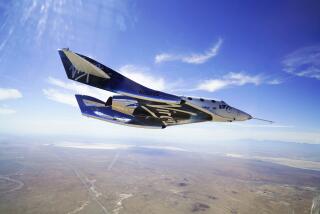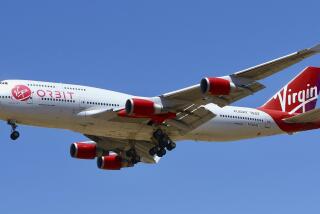New Satellite Phone Venture Is Struggling
- Share via
SAN JOSE — More than 800 miles above Earth, 48 Globalstar Inc. satellites speed silently through space, waiting to beam telephone calls to and from the world’s remote places.
By all accounts, Globalstar’s $4-billion system works beautifully. Using a Globalstar handset, a tourist backpacking in the Australian Outback can call a friend in Milwaukee. A salesman in Slovenia can dial up the home office in New York.
The problem is, hardly anyone is calling.
Potential customers have been turned off by the cost of phones and fear that Globalstar is doomed to follow the downward trajectories of Iridium and ICO Global Communications, earlier attempts to build satellite-based phone systems that turned into costly failures.
By its own estimate, Globalstar needs to sign up a half-million users to break even on operating costs and twice that number to turn a profit.
But after six months of commercial operation, the company has only about 13,000.
Globalstar shares have plunged from a high of $53 to less than $8. The company, which lost $417 million in the first half of 2000, will run out of cash in March unless investors kick in more.
“They’ve got a rough road to go. I wouldn’t write them off, but they’ve definitely got to make a stronger move to get phones out there,” said Greg Caressi, a satellite analyst with Frost & Sullivan.
“The failure of Iridium really poisoned the well for Globalstar. From the outset people were saying ‘You guys can’t make it,’ ” he said.
A year ago, Motorola-backed Iridium, with 55,000 customers, declared bankruptcy, a victim of weak sales, high operating costs and technical glitches. Motorola is making plans to destroy the satellites by allowing them to slide into Earth’s atmosphere.
ICO also ran out of money last year before its first satellites could be launched. ICO emerged from bankruptcy in May and merged with Craig McCaw’s Teledesic LLC, a planned satellite-based telephone and Internet service.
Comparisons to Iridium and ICO annoy Bernard Schwartz, chairman and chief executive of Globalstar and its biggest shareholder, Loral Space & Communications.
“It helps like a nail in the heart,” Schwartz said during a recent, occasionally testy conference call with analysts.
In an interview, Schwartz acknowledged Globalstar is off to a slower start than he expected, but he said momentum is building.
“In both the product marketplace and in the financial marketplace, the Iridium failure had a very strong impact on us,” he said. “It has slowed us down tremendously. Buyers out there who have had a bad experience spending $3,000 on an Iridium phone have built up a lot of resistance, which we are overcoming.”
Globalstar’s vendors are increasing their marketing effort with promotions that have trimmed phone prices from around $1,000 to less than $700. Per-minute charges range from 73 cents to $3, depending on location. Globalstar collects 45 cents per call and vendors get the rest. In areas where the Globalstar vendor offers cellular coverage, the phone switches to cell mode and the customer is billed at regular cellular rates.
Iridium calls ranged from $2 to $4 per minute, although surcharges and taxes imposed by some countries could push the cost higher.
Even before the promotions were launched, Globalstar’s numbers were improving.
Subscribers increased fivefold to 10,000 in the quarter ending June 30, and an additional 3,000 were added in July. Billable minutes more than doubled to 1.14 million in the last quarter.
Globalstar also has signed a deal with In-Flight Network to provide telephone and high-speed Internet service to passengers flying on commercial jets, and is developing other markets for Internet and data transmission services.
Perhaps most important of all, the company’s major backers are prepared to invest an additional $150 million to $200 million, Schwartz said. That, plus $250 million drawn from a credit line in June, will keep the company going through the end of 2001, when Schwartz expects revenue to be high enough to keep Globalstar afloat.
Some analysts worry that may not be enough.
“It gives them more time, but it doesn’t address the real issue, that the phones aren’t selling,” said William Kidd, an analyst with C.E. Unterberg Towbin. “The business just isn’t getting any traction.”
Globalstar sales will pick up as vendors’ marketing campaigns swing into full gear this year, said Andy Radlow, vice president of marketing for Globalstar USA, a Vodafone AirTouch subsidiary distributing phones and service in the United States.
“We’re excited about the quality of service,” he said. “We think that’s the linchpin of making this a financially lucrative service.”
Globalstar was founded in 1991 by Loral, which has 38% of the company, and wireless technology developer Qualcomm Inc., which holds a 7% share. Vodafone also has a 7% stake.
Slow sales haven’t given Qualcomm second thoughts. The company will continue to back Globalstar financially if necessary, said Irwin Jacobs, Qualcomm’s chairman and chief executive. Service operators also will provide more backing as needed, he said.
When it launched service in 1998, Iridium targeted high-level, globe-trotting executives as its primary customers, but found the market too small. Too late, Iridium slashed prices and broadened its marketing to include mining and shipping companies and government agencies, said Motorola spokesman Scott Wyman.
Globalstar is courting a much larger pool of mid-level executives, small-business owners, salespeople and relief organizations that operate in regions that lack reliable landline or cellular telephone service.
The company also hopes to sell phones to mining companies and adventure travelers. It is marketing a fixed-location pay phone to local governments in remote towns in developing countries.
The number of potential customers for satellite phones is estimated to be about 40 million. Globalstar has the capacity to handle 7 million of them, Schwartz said.
Although service is available in more than 30 countries on six continents, it is not yet a true global system. Availability depends on construction of land stations, “gateways,” that process calls relayed by the satellites.
So far, the system covers North America, Australia, Europe and the North Atlantic but only portions of Asia, Africa, the Middle East and South America. All of South America and wider areas of Asia and Africa will be covered by the end of the year.
Roy Schwalback became a believer last month when a friend had a severe allergic reaction during a fishing trip 100 miles off the New Jersey coast.
As Schwalback tried in vain to reach the Coast Guard by radio, his friend began to go into shock. Tragedy was avoided when someone in another boat used a Globalstar phone to call for help. Schwalback, of Annandale, N.J., bought one for himself the next week.
“The most alarming thing was the fact that we couldn’t raise them on the radio,” he said. “I would definitely feel a lot more confident out there having the phone and knowing the phone works.”






